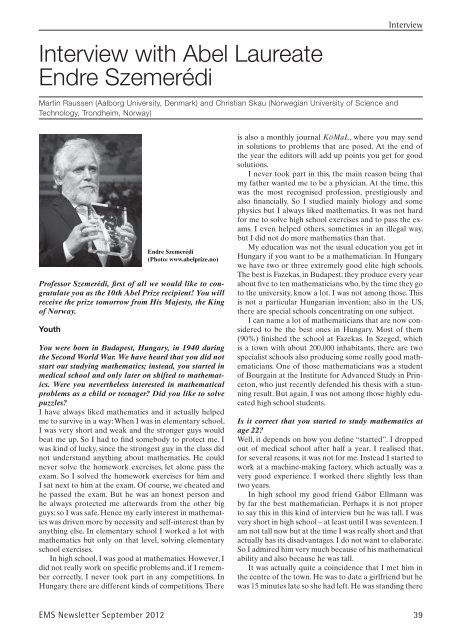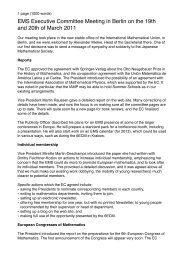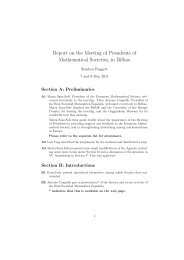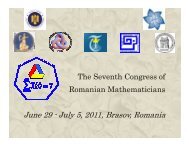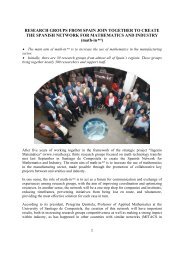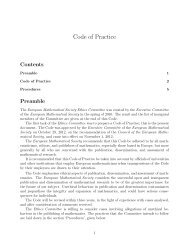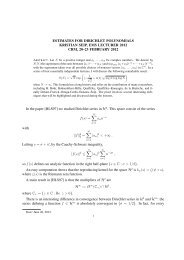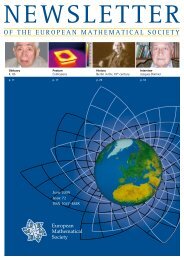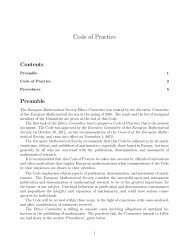Interview with Endre Szemerédi - The European Mathematical Society
Interview with Endre Szemerédi - The European Mathematical Society
Interview with Endre Szemerédi - The European Mathematical Society
Create successful ePaper yourself
Turn your PDF publications into a flip-book with our unique Google optimized e-Paper software.
<strong>Interview</strong> <strong>with</strong> Abel Laureate<br />
<strong>Endre</strong> <strong>Szemerédi</strong><br />
Martin Raussen (Aalborg University, Denmark) and Christian Skau (Norwegian University of Science and<br />
Technology, Trondheim, Norway)<br />
Professor <strong>Szemerédi</strong>, first of all we would like to congratulate<br />
you as the 10th Abel Prize recipient! You will<br />
receive the prize tomorrow from His Majesty, the King<br />
of Norway.<br />
Youth<br />
<strong>Endre</strong> <strong>Szemerédi</strong><br />
(Photo: www.abelprize.no)<br />
You were born in Budapest, Hungary, in 1940 during<br />
the Second World War. We have heard that you did not<br />
start out studying mathematics; instead, you started in<br />
medical school and only later on shifted to mathematics.<br />
Were you nevertheless interested in mathematical<br />
problems as a child or teenager? Did you like to solve<br />
puzzles?<br />
I have always liked mathematics and it actually helped<br />
me to survive in a way: When I was in elementary school,<br />
I was very short and weak and the stronger guys would<br />
beat me up. So I had to find somebody to protect me. I<br />
was kind of lucky, since the strongest guy in the class did<br />
not understand anything about mathematics. He could<br />
never solve the homework exercises, let alone pass the<br />
exam. So I solved the homework exercises for him and<br />
I sat next to him at the exam. Of course, we cheated and<br />
he passed the exam. But he was an honest person and<br />
he always protected me afterwards from the other big<br />
guys; so I was safe. Hence my early interest in mathematics<br />
was driven more by necessity and self-interest than by<br />
anything else. In elementary school I worked a lot <strong>with</strong><br />
mathematics but only on that level, solving elementary<br />
school exercises.<br />
In high school, I was good at mathematics. However, I<br />
did not really work on specific problems and, if I remember<br />
correctly, I never took part in any competitions. In<br />
Hungary there are different kinds of competitions. <strong>The</strong>re<br />
<strong>Interview</strong><br />
is also a monthly journal KöMaL, where you may send<br />
in solutions to problems that are posed. At the end of<br />
the year the editors will add up points you get for good<br />
solutions.<br />
I never took part in this, the main reason being that<br />
my father wanted me to be a physician. At the time, this<br />
was the most recognised profession, prestigiously and<br />
also financially. So I studied mainly biology and some<br />
physics but I always liked mathematics. It was not hard<br />
for me to solve high school exercises and to pass the exams.<br />
I even helped others, sometimes in an illegal way,<br />
but I did not do more mathematics than that.<br />
My education was not the usual education you get in<br />
Hungary if you want to be a mathematician. In Hungary<br />
we have two or three extremely good elite high schools.<br />
<strong>The</strong> best is Fazekas, in Budapest; they produce every year<br />
about five to ten mathematicians who, by the time they go<br />
to the university, know a lot. I was not among those. This<br />
is not a particular Hungarian invention; also in the US,<br />
there are special schools concentrating on one subject.<br />
I can name a lot of mathematicians that are now considered<br />
to be the best ones in Hungary. Most of them<br />
(90%) finished the school at Fazekas. In Szeged, which<br />
is a town <strong>with</strong> about 200,000 inhabitants, there are two<br />
specialist schools also producing some really good mathematicians.<br />
One of those mathematicians was a student<br />
of Bourgain at the Institute for Advanced Study in Princeton,<br />
who just recently defended his thesis <strong>with</strong> a stunning<br />
result. But again, I was not among those highly educated<br />
high school students.<br />
Is it correct that you started to study mathematics at<br />
age 22?<br />
Well, it depends on how you define “started”. I dropped<br />
out of medical school after half a year. I realised that,<br />
for several reasons, it was not for me. Instead I started to<br />
work at a machine-making factory, which actually was a<br />
very good experience. I worked there slightly less than<br />
two years.<br />
In high school my good friend Gábor Ellmann was<br />
by far the best mathematician. Perhaps it is not proper<br />
to say this in this kind of interview but he was tall. I was<br />
very short in high school – at least until I was seventeen. I<br />
am not tall now but at the time I was really short and that<br />
actually has its disadvantages. I do not want to elaborate.<br />
So I admired him very much because of his mathematical<br />
ability and also because he was tall.<br />
It was actually quite a coincidence that I met him in<br />
the centre of the town. He was to date a girlfriend but he<br />
was 15 minutes late so she had left. He was standing there<br />
EMS Newsletter September 2012 39
<strong>Interview</strong><br />
and I ran into him and he asked me what I was doing.<br />
Gábor encouraged me to go to Eötvös University and he<br />
also told me that our mathematics teacher at high school<br />
Sándor Bende agreed <strong>with</strong> his suggestion. As always, I<br />
took his advice; this was really the reason why I went to<br />
university. Looking back, I have tried to find some other<br />
reason but so far I have not been successful.<br />
At that time in Hungary you studied mathematics<br />
and physics for two years, and then one could continue<br />
to study physics, mathematics and pedagogy for three<br />
years in order to become a maths-physics teacher. After<br />
the third year they would choose 15 out of about 200 students<br />
who would specialise in mathematics.<br />
Turán and Erdős<br />
We heard that Paul Turán was the first professor in<br />
mathematics that made a lasting impression on you.<br />
That’s true. In my second year he gave a full-year lecture<br />
on number theory which included elementary number<br />
theory, a little bit of analytic number theory and algebraic<br />
number theory. His lectures were perfect. Somehow he<br />
could speak to all different kinds of students, from the less<br />
good ones to the good ones. I was so impressed <strong>with</strong> these<br />
lectures that I decided I would like to be a mathematician.<br />
Up to that point I was not sure that I would choose this<br />
profession, so I consider Paul Turán to be the one who actually<br />
helped me to decide to become a mathematician.<br />
He is still one of my icons. I have never worked <strong>with</strong><br />
him; I have only listened to his lectures and sometimes I<br />
went to his seminars. I was not a number theorist and he<br />
mainly worked in analytic number theory.<br />
By the way, Turán visited the Institute for Advanced<br />
Study in Princeton in 1948 and he became a very good<br />
friend of the Norwegian mathematician Atle Selberg.<br />
Yes, that is known in Hungary among the circle of mathematicians.<br />
May we ask what other professors at the university in<br />
Budapest were important for you; which of them did<br />
you collaborate <strong>with</strong> later on?<br />
Before the Second World War, Hungarian mathematics<br />
was very closely connected to German mathematics. <strong>The</strong><br />
Riesz brothers, as well as Haar and von Neumann and<br />
many others actually went to Germany after they graduated<br />
from very good high schools in Hungary. Actually,<br />
my wife Anna’s father studied there almost at the same<br />
time as von Neumann and, I guess, the physicist Wigner.<br />
After having finished high school he, and also others,<br />
went to Germany. And after having finished university<br />
education in Germany, most of them went to the US. I<br />
don’t know the exact story but this is more or less the<br />
case. After the Second World War, we were somehow cut<br />
off from Germany. We then had more connections <strong>with</strong><br />
Russian mathematics.<br />
In the late 50s, Paul Erdős, the leading mathematician<br />
in discrete mathematics and combinatorics – actually,<br />
even in probability theory he did very good and famous<br />
work – started to visit Hungary, where his mother lived.<br />
We met quite often. He was a specialist in combinatorics.<br />
At the time combinatorics had the reputation that you<br />
didn’t have to know too much. You just had to sit down<br />
and meditate on a problem. Erdős was outstanding in<br />
posing good problems. Well, of course, as it happens to<br />
most people he sometimes posed questions which were<br />
not so interesting. But many of the problems he posed,<br />
after being solved, had repercussions in other parts of<br />
mathematics – also in continuous mathematics, in fact. In<br />
that sense Paul Erdős was the most influential mathematician<br />
for me, at least in my early mathematical career.<br />
We had quite a lot of joint papers.<br />
Twenty-nine joint papers, according to Wikipedia…<br />
Maybe, I’m not sure. In the beginning I almost exclusively<br />
worked <strong>with</strong> Paul Erdős. He definitely had a lasting<br />
influence on my mathematical thinking and mathematical<br />
work.<br />
Was it usually Erdős who posed the problems or was<br />
there an interaction from the very start?<br />
It was not only <strong>with</strong> me, it was <strong>with</strong> everybody. It was<br />
usually he who came up <strong>with</strong> the problems and others<br />
would work on them. Probably for many he is considered<br />
to be the greatest mathematician in that sense. He posed<br />
the most important problems in discrete mathematics<br />
which actually affected many other areas in mathematics.<br />
Even if he didn’t foresee that solving a particular problem<br />
would have some effect on something else, he had a<br />
very good taste for problems. Not only the solution but<br />
actually the methods used to obtain the solution often<br />
survived the problem itself and were applied in many<br />
other areas of mathematics.<br />
Random methods, for instance?<br />
Yes, he was instrumental in introducing and popularising<br />
random methods. Actually, it is debatable who invented<br />
random methods. <strong>The</strong> Hungarian mathematician Szele<br />
used the so-called random method – it was not a method<br />
yet – to solve a problem. It was not a deterministic solution.<br />
But then Paul Erdős had a great breakthrough result<br />
when he gave a bound on the Ramsey number, still<br />
the central problem in Ramsey <strong>The</strong>ory. After that work<br />
there has been no real progress. A little bit, yes, but nothing<br />
really spectacular. Erdős solved the problem using<br />
random methods. Specifically, he proved that by 2-colouring<br />
the edges of a complete graph <strong>with</strong> n vertices randomly,<br />
then almost certainly there will not be more than<br />
2log n vertices so that all the connecting edges are of the<br />
same colour.<br />
In the US, where I usually teach undergraduate courses,<br />
I present that solution. <strong>The</strong> audience is quite diverse;<br />
many of them do not understand the solution. But the<br />
solution is actually simple and the good students do understand<br />
it. We all know it is extremely important – not<br />
only the solution but the method. <strong>The</strong>n Erdős systematically<br />
started to use random methods. To that point they<br />
just provided a solution for a famous problem but then<br />
he started to apply random methods to many problems,<br />
even deterministic ones.<br />
40 EMS Newsletter September 2012
And, of course, his collaboration <strong>with</strong> Rényi on the<br />
random graph is a milestone in mathematics; it started<br />
almost everything in random graph theory.<br />
And that happened around 1960?<br />
Yes. It was in the 60s and it is considered to be the most<br />
influential paper in random graph theory. <strong>The</strong>ir way of<br />
thinking and their methods are presently of great help<br />
for many, many mathematicians who work on determining<br />
the properties of real-life, large-scale networks and<br />
to find random methods that yield a good model for reallife<br />
networks.<br />
Moscow: Gelfond and Gelfand<br />
You did your graduate work in Moscow in the period<br />
1967–1970 <strong>with</strong> the eminent mathematician Israel<br />
Gelfand as your supervisor. He was not a specialist<br />
in combinatorics. Rumours would have it that you, in<br />
fact, intended to study <strong>with</strong> another Russian mathematician,<br />
Alexander Gelfond, who was a famous number<br />
theorist. How did this happen and whom did you actually<br />
end up working <strong>with</strong> in Moscow?<br />
This can be taken, depending how you look at it, as a joke<br />
or it can be taken seriously. As I have already told you,<br />
I was influenced by Paul Turán, who worked in analytic<br />
number theory. He was an analyst; his mathematics was<br />
much more concrete than what Gelfand and the group<br />
around him studied. At the time, this group consisted of<br />
Kazhdan, Margulis, Manin, Arnold and others, and he<br />
had his famous Gelfand seminar every week that lasted<br />
for hours. It was very frightening sitting there and not understanding<br />
anything. My education was not <strong>with</strong>in this<br />
area at all. I usually had worked <strong>with</strong> Erdős on elementary<br />
problems, mainly <strong>with</strong>in graph theory and combinatorics;<br />
it was very hard for me!<br />
I wanted to study <strong>with</strong> Gelfond but by some unfortunate<br />
misspelling of the name I ended up <strong>with</strong> Gelfand.<br />
That is the truth.<br />
<strong>Interview</strong><br />
Abel Laureate <strong>Endre</strong> <strong>Szemerédi</strong><br />
interviewed by Christian Skau and<br />
Martin Raussen.<br />
(Photo: Eirik Furu Baardsen)<br />
But why couldn’t you swap when you realised that you<br />
had got it wrong?<br />
I will try to explain. I was a so-called candidate student.<br />
That meant that you were sent to Moscow – or to Warsaw<br />
for that matter – for three years. It had already been decided<br />
who would be your supervisor and the system was<br />
quite rigid, though not entirely. I’m pretty sure that if you<br />
put a lot of effort into it, you could change your supervisor,<br />
but it was not so easy. However, it was much worse<br />
if you decided after half a year that it was not the right<br />
option for you, and to go home. It was quite a shameful<br />
thing to just give up. You had passed the exams in Hungary<br />
and kind of promised you were going to work hard<br />
for the next three years. I realised immediately that this<br />
was not for me and Gelfand also realised it and advised<br />
me not to do mathematics anymore, telling me: “Just try<br />
to find another profession; there are plenty in the world<br />
where you may be successful.” I was 27 years old at the<br />
time and he had all these star students aged around 20;<br />
and 27 was considered old!<br />
But in a sense, I was lucky: I went to Moscow in the<br />
Fall of 1967 and, in the Spring next year, there was a conference<br />
on number theory in Hungary – in Debrecen, not<br />
Budapest. I was assigned to Gelfond; it was customary<br />
that every guest had his own Hungarian guide. I had a<br />
special role too, because Gelfond was supposed to buy<br />
clothes and shoes which were hard to get in Russia at the<br />
time for his wife. So I was in the driving seat because I<br />
knew the shops pretty well.<br />
You spoke Russian then?<br />
Well, my Russian was not that good. I don’t know if I<br />
should tell this in this interview but I failed the Russian<br />
exam twice. Somehow I managed to pass the final exam<br />
and I was sent to Russia. My Russian was good enough<br />
for shopping but not good enough for having more complex<br />
conversations. I only had to ask Gelfond for the size<br />
of the shoes he wanted for his wife and then I had a conversation<br />
in Hungarian <strong>with</strong> the shopkeepers. I usually<br />
EMS Newsletter September 2012 41
<strong>Interview</strong><br />
don’t have good taste but because I had to rise to the<br />
occasion, so to say, I was very careful and thought about<br />
it a lot. Later Gelfond told me that his wife was very satisfied.<br />
He was very kind and said that he would arrange<br />
the switch of supervisors!<br />
This happened in the Spring of 1968 but unfortunately<br />
he died that summer of a heart attack, so I stayed <strong>with</strong> Gelfand<br />
for a little more than a year after that. I could have<br />
returned to Hungary but I didn’t want that; when I first<br />
agreed to study there, I felt I had to stay. <strong>The</strong>y, i.e. Gelfand<br />
and the people around him, were very understanding when<br />
they realised that I would never learn what I was supposed<br />
to. Actually my exam consisted of two exercises about representation<br />
theory taken from Kirillov’s book, which they<br />
usually give to third-year students. I did it but there was an<br />
error in my solution. My supervisor was Bernstein, as you<br />
know a great mathematician and a very nice guy, too. He<br />
found the error in the solution but he said that it was the<br />
effort that I had put into it that was important, rather than<br />
the result – and he let me pass the exam.<br />
To become a candidate you had to write a dissertation<br />
and Gelfand let me write one about combinatorics. This<br />
is what I did. So, in a way, I finished my study in Moscow<br />
rather successfully. I did not learn anything but I got the<br />
paper showing that I had become a candidate.<br />
At this time there was a hierarchy in Hungary: doctorate<br />
of the university, then candidate, doctorate of the<br />
academy, then corresponding member of the academy<br />
and then member of the academy. I achieved becoming a<br />
candidate of mathematics.<br />
You had to work entirely on your own in Moscow?<br />
Yes, since I worked in combinatorics.<br />
Gelfond must have realised that you were a good student.<br />
Did he communicate this to Gelfand in any way?<br />
That I don’t know. I only know that Gelfand very soon<br />
realised my lack of mathematical education. But when<br />
Gelfond came to Hungary, he talked to Turán and Erdős<br />
and also to Hungarian number theorists attending that<br />
meeting, and they were telling him: “Here is this guy who<br />
has a very limited background in mathematics.” This may<br />
be the reason why Gelfond agreed to take me as his student.<br />
But unfortunately he died early.<br />
Hungarian mathematics<br />
We would like to come back to Hungarian mathematics.<br />
Considering the Hungarian population is only<br />
about ten million people, the list of famous Hungarian<br />
mathematicians is very impressive. To mention just a<br />
few, there is János Bolyai in the 19th century, one of<br />
the fathers of non-Euclidean geometry. In the 20th century<br />
there is a long list, starting <strong>with</strong> the Riesz brothers,<br />
Frigyes and Marcel, Lipót Fejér, Gábor Szegő, Alfréd<br />
Haar, Tibor Radó, John von Neumann, perhaps the<br />
most ingenious of them all, Paul Turán, Paul Erdős,<br />
Alfréd Rényi, Raoul Bott (who left the country early<br />
but then became famous in the United States). Among<br />
those still alive, you have Peter Lax, who won the Abel<br />
Prize in 2005, Bela Bollobás, who is in Great Britain,<br />
László Lovász and now you. It’s all very impressive.<br />
You have already mentioned some facts that may<br />
explain the success of Hungarian mathematics. Could<br />
you elaborate, please?<br />
We definitely have a good system to produce elite mathematicians,<br />
and we have always had that. At the turn of<br />
the century – we are talking about the 19th century and<br />
the beginning of the 20th century – we had two or three<br />
absolutely outstanding schools, not only the so-called<br />
Fasori where von Neumann and Wigner studied but<br />
also others. We were able to produce a string of young<br />
mathematicians, some of whom later went abroad and<br />
became great mathematicians – or great physicists, for<br />
that matter. In that sense I think the educational system<br />
was extremely good. I don’t know whether the general<br />
education was that good but definitely for mathematics<br />
and theoretical physics it was extremely good. We had at<br />
least five top schools that concentrated on these two subjects;<br />
and that is already good enough to produce some<br />
great mathematicians and physicists.<br />
Back to the question of whether the Hungarians are<br />
really so good or not. Definitely, in discrete mathematics<br />
there was a golden period. This was mainly because of<br />
the influence of Erdős. He always travelled around the<br />
world but he spent also a lot of time in Hungary. Discrete<br />
mathematics was certainly the strongest group.<br />
<strong>The</strong> situation has changed now. Many Hungarian students<br />
go abroad to study at Princeton, Harvard, Oxford,<br />
Cambridge or Paris. Many of them stay abroad but many<br />
of them come home and start to build schools. Now we<br />
cover a much broader spectrum of mathematics, like algebraic<br />
geometry, differential geometry, low-dimensional<br />
topology and other subjects. In spite of being myself<br />
a mathematician working in discrete mathematics who<br />
practically doesn’t know anything about these subjects, I<br />
am very happy to see this development.<br />
You mentioned the journal KöMaL that has been influential<br />
in promoting mathematics in Hungary. You told<br />
us that you were not personally engaged, but this journal<br />
was very important for the development of Hungarian<br />
mathematics; isn’t that true?<br />
You are absolutely right. This journal is meant for a wide<br />
audience. Every month the editors present problems,<br />
mainly from mathematics but also from physics. At least<br />
in my time, in the late 50s, it was distributed to every high<br />
school and a lot of the students worked on these problems.<br />
If you solved the problems regularly then by the<br />
time you finished high school you would almost know as<br />
much as the students in the elite high schools. <strong>The</strong> editors<br />
added the points you got from each correct solution at<br />
the end of the year, giving a bonus for elegant solutions.<br />
Of course, the winners were virtually always from one of<br />
these elite high schools.<br />
But it was intended for a much wider audience and<br />
it helped a lot of students, not only mathematicians. In<br />
particular, it also helped engineers. People may not know<br />
this but we have very good schools for different kinds<br />
of engineering, and a lot of engineering students-to-be<br />
42 EMS Newsletter September 2012
actually solved these problems. <strong>The</strong>y may not have been<br />
among the best but it helped them to develop a kind of<br />
critical thinking. You just don’t make a statement but you<br />
try to see connections and put them together to solve<br />
the problems. So by the time they went to engineering<br />
schools, which by itself required some knowledge of<br />
mathematics, they were already quite well educated in<br />
mathematics because of KöMaL.<br />
KöMaL plays an absolutely important role and, I<br />
would like to emphasise, not only in mathematics but<br />
more generally in natural sciences. Perhaps even students<br />
in the humanities are now working on these problems. I<br />
am happy for that and I would advise them to continue to<br />
do so (of course not to the full extent because they have<br />
many other things to study).<br />
Important methods and results<br />
We would now like to ask you some questions about<br />
your main contributions to mathematics.<br />
You have made some groundbreaking – and we don’t<br />
think that this adjective is an exaggeration – discoveries<br />
in combinatorics, graph theory and combinatorial<br />
number theory. But arguably, you are most famous for<br />
what is now called the <strong>Szemerédi</strong> theorem, the proof of<br />
the Erdős-Turán conjecture from 1936.<br />
Your proof is extremely complicated. <strong>The</strong> published<br />
proof is 47 pages long and it has been called a masterpiece<br />
of combinatorial reasoning. Could you explain<br />
first of all what the theorem says, the history behind it<br />
and why and when you got interested in it?<br />
Yes, I will start in a minute to explain what it is but I suspect<br />
that not too many people have read it. I will explain<br />
how I got to the problem. But first I want to tell how the<br />
whole story started. It started <strong>with</strong> the theorem of van der<br />
Waerden: you fix two numbers, say five and three. <strong>The</strong>n<br />
you consider the integers up to a very large number, from<br />
1 to n, say. <strong>The</strong>n you partition this set into five classes, and<br />
then there will always be a class containing a three-term<br />
arithmetic progression. That was a fundamental result of<br />
van der Waerden, of course not only <strong>with</strong> three and five<br />
but <strong>with</strong> general parameters.<br />
Later, Erdős and Turán meditated over this result. <strong>The</strong>y<br />
thought that maybe the reason why there is an arithmetic<br />
progression is not the partition itself; if you partition into<br />
five classes then one class contains at least one fifth of all<br />
the numbers. <strong>The</strong>y made the conjecture that what really<br />
counts is that you have dense enough sets.<br />
That was the Erdős-Turán conjecture: if your set is<br />
dense enough in the interval 1 to n – we are of course<br />
talking about integers – then it will contain a long arithmetic<br />
progression. Later Erdős formulated a very brave<br />
and much stronger conjecture: let’s consider an infinite<br />
sequence of positive integers, a 1 < a 2 < … such that the<br />
sum of the inverses {1/a i } is divergent. <strong>The</strong>n the infinite sequence<br />
contains arbitrarily long arithmetic progressions.<br />
Of course, this would imply the absolutely fundamental<br />
result of Green and Tao about arbitrarily long arithmetic<br />
progressions <strong>with</strong>in the primes because for the primes<br />
we know that the sum of the inverses is divergent.<br />
<strong>Interview</strong><br />
That was a very brave conjecture; it isn’t even solved<br />
for arithmetic progressions of length k = 3. But now, people<br />
have come very close to proving it: Tom Sanders<br />
proved that if we have a subset between 1 and n containing<br />
at least n over log n(log log n) 5 elements then the<br />
subset contains a 3-term arithmetic progression. Unfortunately,<br />
we need a little bit more but we are getting close<br />
to solving Erdős’s problem for k = 3 in the near future,<br />
which will be a great achievement. If I’m not mistaken,<br />
Erdős offered 3,000 USD for the solution of the general<br />
case a long time ago. If you consider inflation, that means<br />
quite a lot of money.<br />
Erdős offered 1,000 USD for the problem you solved,<br />
and that’s the highest sum he ever paid, right?<br />
Erdős offered $1,000 as well for a problem in graph theory<br />
that was solved by V. Rödl and P. Frankl. <strong>The</strong>se are the<br />
two problems I know about.<br />
Let us get back to how you got interested in the problem.<br />
That was very close to the Gelfand/Gelfond story, at least<br />
in a sense. At least the message is the same: I overlooked<br />
facts. I tried to prove that if you have an arithmetic progression<br />
then it cannot happen that the squares are dense<br />
inside of it; specifically, it cannot be that a positive fraction<br />
of the elements of this arithmetic progression are squares.<br />
I was about 25 years old at the time and at the end of<br />
my university studies. At that time I already worked <strong>with</strong><br />
Erdős. I very proudly showed him my proof because I<br />
thought it was my first real result. <strong>The</strong>n he pointed out<br />
two, well not errors but deficiencies in my proof. Firstly, I<br />
had assumed that it was known that r 4 (n) = o(n) 1 , i.e. that<br />
if you have a set of positive upper density then it has to<br />
contain an arithmetic progression of length four, or for<br />
that matter of any length. I assumed that that was a true<br />
statement. <strong>The</strong>n I used that there are no four squares that<br />
form an arithmetic progression. However, Erdős told me<br />
that the first statement was not known; it was an open<br />
problem. <strong>The</strong> other one was already known to Euler,<br />
which was 250 years before my time. So I had assumed<br />
something that is not known and, on the other hand, I had<br />
proved something that had been proven 250 years ago!<br />
<strong>The</strong> only way to try to correct something so embarrassing<br />
was to start working on the arithmetic progression<br />
problem. That was the time I started to work on<br />
r 4 (n) and, more generally, on r k (n). First I took a look at<br />
Klaus Roth’s proof from 1953 of r 3 (n) being less than n<br />
divided by log log n . I came up <strong>with</strong> a very elementary<br />
proof for r 3 (n) = o(n) so that even high school students<br />
could understand it easily. That was the starting point.<br />
Later I proved also that r 4 (n) = o(n).<br />
Erdős arranged for me to be invited to Nottingham<br />
to give a talk on that result. But my English was virtually<br />
non-existent. Right now you can still judge that there is<br />
room for improvement of my English, but at the time it<br />
was almost non-existent. I gave a series of lectures; Peter<br />
1 r k (n) denotes the proportion of elements between 1 and n<br />
that a subset must contain in order for it to contain an arithmetic<br />
progression of length k.<br />
EMS Newsletter September 2012 43
<strong>Interview</strong><br />
Elliot and Edward Wirsing, both extremely strong mathematicians,<br />
wrote a paper based almost entirely on my<br />
pictures on the blackboard. Perhaps they understood<br />
some easy words in English that I used. Anyway, they<br />
helped to write up the paper for me. A similar thing happened<br />
when I solved r k (n) = o(n) for general k. <strong>The</strong>n my<br />
good friend András Hajnal helped me to write up the paper.<br />
That is actually an understatement. <strong>The</strong> truth is that<br />
he listened to my explanations and he then wrote up the<br />
paper. I am very grateful to Peter Elliot, Edward Wirsing<br />
and to my good friend András for their invaluable help.<br />
When did all this happen?<br />
It was in 1973. <strong>The</strong> paper appeared in Acta Arithmetica<br />
in 1975. <strong>The</strong>re is a controversial issue – well, maybe controversial<br />
is too strong a word – about the proof. It is<br />
widely said that one of the main tools in the proof is the<br />
so-called regularity lemma, which is not true in my opinion.<br />
Well, everybody forgets about the proofs they produced<br />
30 years ago. But I re-read my paper and I couldn’t<br />
find the regularity lemma. <strong>The</strong>re occurs a lemma in the<br />
proof which is similar to the regularity lemma, so maybe<br />
that lemma, which is definitely not the regularity lemma,<br />
inspired me later to prove the regularity lemma.<br />
<strong>The</strong> real story is that I heard Bollobás’ lectures from<br />
1974 about strengthening the Erdős–Stone theorem. <strong>The</strong><br />
Erdős–Stone theorem from the 40s was also a breakthrough<br />
result but I don’t want to explain it here. <strong>The</strong>n<br />
Bollobás and Erdős strengthened it. I listened to Bollobás’<br />
lectures and tried to improve their result. <strong>The</strong>n it<br />
struck me that a kind of regularity lemma would come in<br />
handy and this led me to proving the regularity lemma.<br />
I am very grateful to Vasek Chvatal who helped me to<br />
write down the regularity paper. Slightly later the two of<br />
us gave a tight bound for the Erdős-Stone theorem.<br />
I’ve seen that people refer to it in your proof of the<br />
Erdős-Turán conjecture as a weakened form of the regularity<br />
lemma.<br />
Yes, weaker; but similar in ideology, so to speak.<br />
Connections to ergodic theory<br />
Your proof of the <strong>Szemerédi</strong> <strong>The</strong>orem is the beginning<br />
of a very exciting story. We have heard from a reliable<br />
source that Hillel Furstenberg at the Hebrew University<br />
in Jerusalem first learned about your result when somebody<br />
gave a colloquium talk there in December 1975<br />
and mentioned your theorem. Following the talk, there<br />
was a discussion in which Furstenberg said that his<br />
weak mixing of all orders theorem, which he already<br />
knew, would prove the ergodic version of the <strong>Szemerédi</strong><br />
<strong>The</strong>orem in the weak mixing case. Since the Kronecker<br />
(or compact) case is trivial, one should be able to interpolate<br />
between them so as to get the full ergodic version.<br />
It took a couple of months for him to work out the<br />
details which became his famous multiple recurrence<br />
theorem in ergodic theory.<br />
We find it very amazing that the <strong>Szemerédi</strong> <strong>The</strong>orem<br />
and Furstenberg’s Multiple Recurrence <strong>The</strong>orem are<br />
equivalent, in the sense that one can deduce one theorem<br />
from the other. We guess it is not off the mark to<br />
say that Furstenberg’s proof gave a conceptual framework<br />
for your theorem. What are your comments?<br />
As opposed to me, Furstenberg is an educated mathematician.<br />
He is a great mathematician and he already had great<br />
results in ergodic theory; he knew a lot. He proved that<br />
a measure-preserving system has a multiple recurrence<br />
property; this is a far-reaching generalisation of a classical<br />
result by Poincaré. Using his result, Furstenberg proved<br />
my result on the k-term arithmetic progressions. So that<br />
is the short story about it. But I have to admit that his<br />
method is much stronger because it could be generalised<br />
to a multi-dimensional setting. Together <strong>with</strong> Katznelson<br />
he proved that in 1978. <strong>The</strong>y could actually also prove the<br />
density Hales–Jewett theorem but it took more than ten<br />
years. <strong>The</strong>n Bergelson and Leibman proved a polynomial<br />
version of the arithmetic progression result, much stronger<br />
than the original one. I doubt that you can get it by<br />
elementary methods but that is only my opinion. I will bet<br />
that they will not come up <strong>with</strong> a proof of the polynomial<br />
version <strong>with</strong>in the next ten years by using elementary<br />
methods.<br />
But then very interesting things happened. Tim Gowers<br />
started the so-called Polymath Project: many people communicated<br />
<strong>with</strong> each other on the internet and decided that<br />
they would try to give a combinatorial proof of the Hales–<br />
Jewett density theorem using only elementary methods.<br />
After two months, they come up <strong>with</strong> an elementary proof.<br />
<strong>The</strong> density Hales–Jewett theorem was considered to be by<br />
far the hardest result proved by Furstenberg and Katznelson<br />
and its proof is very long. <strong>The</strong> elementary proof of the<br />
density Hales–Jewett theorem is about 25 pages long.<br />
<strong>The</strong>re is now a big discussion among mathematicians<br />
whether one can use this method to solve other problems.<br />
Joint papers are very good, when a small group of mathematicians<br />
cooperate. But the Polymath Project is different:<br />
hundreds of people communicate. You may work on<br />
something your whole life, then a hundred people appear<br />
and many of them are ingenious. <strong>The</strong>y solve your problem<br />
and you are slightly disappointed. Is this a good thing?<br />
<strong>The</strong>re is a big discussion among mathematicians about<br />
this method. I am for it. I will soon turn 72 years old, so I<br />
believe I can evaluate it <strong>with</strong>out any self-interest.<br />
Still, all this started <strong>with</strong> your proof of the Erdős-Turán<br />
conjecture. You mentioned Green-Tao. An important<br />
ingredient in their proof of the existence of arithmetic<br />
progressions of arbitrary length <strong>with</strong>in the primes is a<br />
<strong>Szemerédi</strong>-type argument involving so-called pseudoprimes,<br />
whatever that is. So the ramifications of your<br />
theorem have been impressive.<br />
In their abstract they say that the three main ingredients<br />
in their proof are the Goldstone–Yıldırım result<br />
which gives an estimate for the difference of consecutive<br />
primes, their transference principle and my theorem on<br />
arithmetic progressions.<br />
By the way, according to Green and Tao one could have<br />
used the Selberg sieve instead.<br />
44 EMS Newsletter September 2012
You are right. However, in my opinion the main revolutionary<br />
new idea is their transference principle that<br />
enables us to go from a dense set to a sparse set. I would<br />
like to point out that later, while generalising their theorem,<br />
they did not have to use my theorem. Terry Tao said<br />
that he read all the proofs of the <strong>Szemerédi</strong> theorem and<br />
compared them, and then he and Ben Green meditated<br />
on it. <strong>The</strong>y were probably more inspired by Furstenberg’s<br />
method, the ergodic method. That is at least my take on<br />
this thing but I am not an expert on ergodic theory.<br />
But Furstenberg’s theorem came after and was inspired<br />
by yours. So however you put it, it goes back to you.<br />
Yes, that is what they say.<br />
We should mention that Tim Gowers also gave a proof<br />
of the <strong>Szemerédi</strong> <strong>The</strong>orem.<br />
He started <strong>with</strong> Roth’s method, which is an estimation of<br />
exponential sums. Roth proved in his paper that r 3 (n) is<br />
less than n divided by log log n. Tim Gowers’ fundamental<br />
work did not only give an absolutely strong bound<br />
for the size of a set A in the interval [1,n] not containing<br />
a k-term arithmetic progression; he also invented methods<br />
and concepts that later became extremely influential.<br />
He introduced a norm (actually, several norms), which<br />
is now called the Gowers norm. This norm controls the<br />
randomness of a set. If the Gowers norm is big, he proved<br />
that it is correlated <strong>with</strong> a higher order phase function,<br />
which is a higher order polynomial. Gowers, and independently<br />
Rödl, Naegle, Schacht and Skokan, proved the<br />
hypergraph regularity lemma and the hypergraph counting<br />
lemma, which are main tools in additive combinatorics<br />
and in theoretical computer science.<br />
We should mention that Gowers received the Fields<br />
Medal in 1998 and that Terence Tao got it in 2006. Also,<br />
Roth was a Fields Medal recipient back in 1958.<br />
Random graphs and the regularity lemma<br />
Let’s get back to the so-called <strong>Szemerédi</strong> regularity<br />
theorem. You have to explain the notions of random<br />
graphs and extremal graphs because they are involved<br />
in this result.<br />
How can we imagine a random graph? I will talk only<br />
about the simplest example. You have n points and the<br />
edges are just the pairs, so each edge connects two points.<br />
We say that the graph is complete if you include all the<br />
edges, but that is, of course, not an interesting object. In<br />
one model of the random graph, you just close your eyes<br />
and <strong>with</strong> probability ½, you choose an edge. <strong>The</strong>n you<br />
will eventually get a graph. That is what we call a random<br />
graph, and most of them have very nice properties.<br />
You just name any configuration – like 4-cycles C 4 for<br />
instance, or the complete graph K 4 – then the number<br />
of such configurations is as you would expect. A random<br />
graph has many beautiful properties and it satisfies almost<br />
everything. Extremal graph theory is about finding<br />
a configuration in a graph. If you know that your graph is<br />
a random graph, you can prove a lot of things.<br />
<strong>Interview</strong><br />
<strong>The</strong> regularity lemma is about the following. If you<br />
have any graph – unfortunately we have to assume a<br />
dense graph, which means that you have a lot of edges –<br />
then you can break the vertex set into a relatively small<br />
number of disjoint vertex sets, so that if you take almost<br />
any two of these vertex sets, then between them the socalled<br />
bipartite graph will behave like a random graph.<br />
We can break our graph into not too many pieces, so we<br />
can work <strong>with</strong> these pieces and we can prove theorems in<br />
extremal graph theory.<br />
We can also use it in property testing, which belongs<br />
to theoretical computer science and many other areas. I<br />
was surprised that they use it even in biology and neuroscience<br />
but I suspect that they use it in an artificial way<br />
– that they could do <strong>with</strong>out the regularity lemma. But I<br />
am not an expert on this so I can’t say this for sure.<br />
<strong>The</strong> regularity lemma really has some important applications<br />
in theoretical computer science?<br />
Yes, it has; mainly in property testing but also in constructing<br />
algorithms. Yes, it has many important applications.<br />
Not only the original regularity lemma but, since<br />
this is 30 years ago, there have appeared modifications of<br />
the regularity lemma which are more adapted for these<br />
purposes. <strong>The</strong> regularity lemma is for me just a philosophy.<br />
Not an actual theorem. Of course, the philosophy is<br />
almost everything. That is why I like to say that in every<br />
chaos there is an order. <strong>The</strong> regularity lemma just says<br />
that in every chaos there is a big order.<br />
Do you agree that the <strong>Szemerédi</strong> theorem, i.e. the proof<br />
of the Erdős–Turán conjecture, is your greatest achievement?<br />
It would be hard to disagree because most of my colleagues<br />
would say so. However, perhaps I prefer another<br />
result of mine <strong>with</strong> Ajtai and Komlós. In connection <strong>with</strong><br />
a question about Sidon sequences we discovered an innocent<br />
looking lemma. Suppose we have a graph of n vertices<br />
in which a vertex is connected to at most d other vertices.<br />
By a classical theorem of Turán, we can always find at least<br />
n/d vertices such that no two of them are connected by an<br />
edge. What we proved was that under the assumption that<br />
the graph contains no triangle, a little more is true: one can<br />
find n/d times log d vertices <strong>with</strong> the above property.<br />
I am going to describe the proof of the lemma very<br />
briefly. We choose n/2d vertices of our graph randomly.<br />
<strong>The</strong>n we omit all the neighbours of the points in the chosen<br />
sets. This is, of course, a deterministic step. <strong>The</strong>n in<br />
the remaining vertex set we again choose randomly n/2d<br />
vertices and again deterministically omit the neighbours<br />
of the chosen set. It can be proved that this procedure<br />
can be repeated log d times and in the chosen set the<br />
average degree is at most 2. So in the chosen sets we can<br />
find a set of size at least n/4d such that no two points are<br />
connected <strong>with</strong> an edge.<br />
Because of the mixture of random steps and deterministic<br />
steps we called this new technique the “semirandom<br />
method”.<br />
Historically, the first serious instance of a result of extremal<br />
graph theory was the famous theorem of Ramsey,<br />
EMS Newsletter September 2012 45
<strong>Interview</strong><br />
and, in a quantitative form, of Erdős and Szekeres. This<br />
result has also played a special role in the development of<br />
the “random method”. <strong>The</strong>refore it has always been a special<br />
challenge for combinatorialists to try to determine the<br />
asymptotic behaviour of the Ramsey functions R(k,n) 2 , as<br />
n (or both k and n) tend to infinity. It can be easily deduced<br />
from our lemma that R(3,n) < cn 2 /log n, which solved a<br />
longstanding open problem of Erdős. Surprisingly, about<br />
10 years later, Kim proved that the order of magnitude of<br />
our bound was the best possible. His proof is based on a<br />
brilliant extension of the “semirandom method”.<br />
<strong>The</strong> “semirandom method” has found many other applications.<br />
For instance, together <strong>with</strong> Komlós and Pintz<br />
I used the same technique to disprove a famous geometric<br />
conjecture of Heilbronn. <strong>The</strong> conjecture dates back<br />
to the 40s. <strong>The</strong> setting is as follows: you have n points in<br />
the unit square and you consider the triangles defined by<br />
these points. <strong>The</strong>n the conjecture says that you can always<br />
choose a triangle of area smaller than a constant over n 2 .<br />
That was the Heilbronn conjecture. For the bound 1/n,<br />
this is trivial, and then Klaus Roth improved this to 1 over<br />
n(log log n) ½ . Later Wolfgang Schmidt improved it further<br />
to 1 over n(log n) ½ . Roth, in a very brilliant and surprising<br />
way, used analysis to prove that we can find a triangle of<br />
area less than 1 over n (1+a) , where a is a constant.<br />
We then proved, using the semi-random method, that<br />
it is possible to put down n points such that the smallest<br />
area of a triangle is at least log n over n 2 , disproving the<br />
Heilbronn conjecture. Roth told us that he gave a series<br />
of talks about this proof.<br />
Further research areas<br />
It is clear from just checking the literature and talking<br />
<strong>with</strong> people familiar <strong>with</strong> graph theory and combinatorics,<br />
as well as additive number theory, that you –<br />
sometimes <strong>with</strong> co-authors – have obtained results that<br />
have been groundbreaking and have set the stage for<br />
some very important developments. Apart from the <strong>Szemerédi</strong><br />
theorem and the regularity lemma that we have<br />
already talked about, here is a short list of important<br />
results that you and your co-authors have obtained:<br />
(i) <strong>The</strong> <strong>Szemerédi</strong>-Trotter theorem in the paper<br />
“Extremal problems in discrete geometry” from<br />
1983.<br />
(ii) <strong>The</strong> Erdős–<strong>Szemerédi</strong> theorem on product-sum estimates,<br />
in the paper “On sums and products of<br />
integers” from 1983.<br />
(iii) <strong>The</strong> results obtained by AKS, which is the acronym<br />
for Miklós Ajtai, János Komlós and <strong>Endre</strong><br />
<strong>Szemerédi</strong>. <strong>The</strong> “sorting algorithm” is among the<br />
highlights.<br />
Could you fill in some details, please?<br />
(i) Euclid’s system of axioms states some of the basic<br />
facts about incidences between points and lines in the<br />
2 R(k,n) denotes the least positive integer N such that for any<br />
(red/blue)-coloring of the complete graph K N on N vertices,<br />
there exists either an entirely red complete subgraph on k<br />
vertices or an entirely blue complete subgraph on n vertices.<br />
plane. In the 1940s, Paul Erdős started asking slightly<br />
more complicated questions about incidences that<br />
even Euclid would have understood. How many incidences<br />
can occur among m points and n lines, where<br />
an “incidence” means that a line passes through a<br />
point? My theorem <strong>with</strong> Trotter confirmed Erdős’<br />
rather surprising conjecture: the maximal number of<br />
incidences is much smaller in the real plane than in<br />
the projective one – much smaller than what we could<br />
deduce by simple combinatorial considerations.<br />
(ii) Together <strong>with</strong> Paul Erdős, we discovered an interesting<br />
phenomenon and made the first non-trivial<br />
step in exploring it. We noticed, roughly speaking,<br />
that a set of numbers may have nice additive properties<br />
or nice multiplicative properties but not both<br />
at the same time.<br />
This has meanwhile been generalised to finite fields<br />
and other structures by Bourgain, Katz, Tao and<br />
others. <strong>The</strong>ir results had far-reaching consequences<br />
in seemingly unrelated fields of mathematics.<br />
(iii) We want to sort n numbers, that is, to put them in<br />
increasing order by using comparisons of pairs of elements.<br />
Our algorithm is non-adaptive: the next comparison<br />
never depends on the outcome of the previous<br />
ones. Moreover, the algorithm can efficiently<br />
run simultaneously on cn processors such that every<br />
number is processed by only one of them at a time.<br />
Somewhat surprisingly, our algorithm does not require<br />
more comparisons than the best possible adaptive<br />
non-parallel algorithm. It is well known that any<br />
sorting algorithm needs at least n log n comparisons.<br />
What are, in your opinion, the most interesting and<br />
important open problems in combinatorics and graph<br />
theory?<br />
I admit that I may be somewhat conservative in taste.<br />
<strong>The</strong> problem that I would like to see solved is the very<br />
first problem of extremal graph theory: to determine the<br />
asymptotic behaviour of the Ramsey functions.<br />
Combinatorics compared to other areas of<br />
mathematics<br />
It is said, tongue in cheek, that a typical combinatorialist<br />
is a bright mathematician <strong>with</strong> an aversion to<br />
learning or embracing abstract mathematics. Does this<br />
description fit you?<br />
I am not sure. In combinatorics we want to solve a concrete<br />
problem, and by solving a problem we try to invent<br />
new methods. And it goes on and on. Sometimes we actually<br />
borrow from so-called well established mathematics.<br />
People in other areas of mathematics often work in ways<br />
that are different from how we do in combinatorics.<br />
Let’s exaggerate somewhat: they have big theories<br />
and they find sometimes a problem for the theory. In<br />
combinatorics, it is usually the other way around. We<br />
start <strong>with</strong> problems which actually are both relevant and<br />
necessary; that is, the combinatorics itself requires the<br />
solution of the problems; the problems are not randomly<br />
chosen. You then have to find methods which you apply<br />
to solve the problems and sometimes you might create<br />
46 EMS Newsletter September 2012
theory. But you start out by having a problem; you do not<br />
start by having a theory and then finding a problem for<br />
which you can apply the theory. Of course, that happens<br />
from time to time but it is not the major trend.<br />
Now, in the computer era, it is unquestionable that<br />
combinatorics is extremely important. If you want to run<br />
programs efficiently, you have to invent algorithms in advance<br />
and these are basically combinatorial in nature. This<br />
is perhaps the reason why combinatorics today is a little<br />
bit elevated, so to say, and that mathematicians from other<br />
fields start to realise this and pay attention. If you look at<br />
the big results, many of them have big theories which I<br />
don’t understand, but at the very root there is often some<br />
combinatorial idea. This discussion is a little bit artificial.<br />
It’s true that combinatorics was a second rated branch of<br />
mathematics 30 years ago but hopefully not any longer.<br />
Do you agree <strong>with</strong> Bollobás who in an interview from<br />
2007 said the following:<br />
“<strong>The</strong> trouble <strong>with</strong> the combinatorial problems is that<br />
they do not fit into the existing mathematical theories.<br />
We much more prefer to get help from “mainstream”<br />
mathematics rather than to use “combinatorial” methods<br />
only, but this help is rarely forthcoming. However,<br />
I am happy to say that the landscape is changing.”<br />
I might agree <strong>with</strong> that.<br />
Gowers wrote a paper about the two cultures <strong>with</strong>in<br />
mathematics. <strong>The</strong>re are problem solvers and there are<br />
theory builders. His argument is that we need both. He<br />
says that the organising principles of combinatorics are<br />
less explicit than in core mathematics. <strong>The</strong> important<br />
ideas in combinatorial mathematics do not usually appear<br />
in the form of precisely stated theorems but more<br />
often as general principles of wide applicability.<br />
I guess that Tim Gowers is right. But there is interplay<br />
between the two disciplines. As Bollobás said, we borrow<br />
from the other branches of mathematics if we can,<br />
when we solve concrete discrete problems, and vice versa.<br />
I once sat in class when a beautiful result in analytic<br />
number theory was presented. I understood only a part<br />
of it. <strong>The</strong> mathematician who gave the talk came to the<br />
bottleneck of the whole argument. I realised that it was a<br />
combinatorial statement and if you gave it to a combinatorialist,<br />
he would probably have solved it. Of course, one<br />
would have needed the whole machinery to prove the<br />
result in question but at the root it actually boiled down<br />
to a combinatorial argument. A real interplay!<br />
<strong>The</strong>re is one question that we have asked almost all<br />
Abel Prize recipients; it concerns the development of<br />
important new concepts and ideas. If you recollect:<br />
would key ideas turn up when you were working hard<br />
at your desk on a problem or did they show up in more<br />
relaxed situations? Is there any pattern?<br />
Actually, both! Sometimes you work hard on a problem<br />
for half a year and nothing comes out. <strong>The</strong>n suddenly<br />
you see the solution, and you are surprised and slightly<br />
ashamed that you haven’t noticed these trivial things<br />
which actually finish the whole proof, and which you did<br />
<strong>Interview</strong><br />
not discover for a long time. But usually you work hard<br />
and step-by-step you get closer to the solution. I guess<br />
that this is the case in every science. Sometimes the solution<br />
comes out of the blue but sometimes several people<br />
are working together and find the solution.<br />
I have to tell you that my success ratio is actually very<br />
bad. If I counted how many problems I have worked on<br />
and in how many problems I have been successful, the<br />
ratio would be very bad.<br />
Well, in all fairness this calculation should take into consideration<br />
how many problems you have tried to solve.<br />
Right, that is a nice remark.<br />
You have been characterised by your colleagues – and<br />
this is meant as a huge compliment – as having an “irregular<br />
mind”. Specifically, you have been described<br />
as having a brain that is wired differently than most<br />
mathematicians. Many admire your unique way of<br />
thinking, your extraordinary vision. Could you try to<br />
explain to us how you go about attacking problems? Is<br />
there a particular method or pattern?<br />
I don’t particularly like the characterisation of having an<br />
“irregular mind”. I don’t feel that my brain is wired differently<br />
and I think that most neurologists would agree<br />
<strong>with</strong> me. However, I believe that having unusual ideas<br />
can often be useful in mathematical research. It would<br />
be nice to say that I have a good general approach of<br />
attacking mathematical problems. But the truth is that<br />
after many years of research I still do not have any idea<br />
what the right approach is.<br />
Mathematics and computer science<br />
We have already talked about connections between discrete<br />
mathematics and computer science – you are in<br />
fact a professor in computer science at Rutgers University<br />
in the US. Looking back, we notice that for some<br />
important mathematical theorems, like the solution of<br />
the four-colour problem for instance, computer power<br />
has been indispensable. Do you think that this is a<br />
trend? Will we see more results of this sort?<br />
Yes, there is a trend. Not only for this but also for other<br />
types of problems as well where computers are used extensively.<br />
This trend will continue, even though I am not a<br />
computer expert. I am at the computer science department<br />
but fortunately nobody asked me whether I could answer<br />
email, which I cannot! <strong>The</strong>y just hired me because so-called<br />
theoretical computer science was highly regarded in the late<br />
80s. Nowadays, it does not enjoy the same prestige, though<br />
the problems are very important, the P versus NP problem,<br />
for instance. We would like to understand computation and<br />
how fast it is; this is absolutely essential mathematics, and<br />
not only for discrete mathematics. <strong>The</strong>se problems lie at<br />
the heart of mathematics, at least in my opinion.<br />
May we come back to the P versus NP problem which<br />
asks whether every problem whose solution can be verified<br />
quickly by a computer can also be solved quickly<br />
by a computer. Have you worked on it yourself?<br />
EMS Newsletter September 2012 47
<strong>Interview</strong><br />
I am working on two problems in computer science. <strong>The</strong><br />
first one is the following: assume we compute an n-variable<br />
Boolean function <strong>with</strong> a circuit. For most of the nvariable<br />
Boolean functions the circuit size is not polynomial.<br />
But to the best of my knowledge, we do not know<br />
a particular function which cannot be computed <strong>with</strong> a<br />
Boolean circuit of linear size and depth log n. I have no<br />
real idea how to solve this problem.<br />
<strong>The</strong> second one is the minimum weight spanning tree<br />
problem; again, so far I am unsuccessful.<br />
I have decided that now I will, while keeping up <strong>with</strong><br />
combinatorics, learn more about analytic number theory.<br />
I have in mind two or three problems, which I am not<br />
going to tell you. It is not the Riemann hypothesis; that<br />
I can tell.<br />
<strong>The</strong> P versus NP conjecture is on the Clay list of problems,<br />
the prize money for a solution being one million<br />
USD, so it has a lot of recognition.<br />
Many people believe that the P versus NP problem is the<br />
most important one in current mathematics, regardless of<br />
the Riemann hypothesis and the other big problems. We<br />
should understand computation. What is in our power? If<br />
we can check easily that something is true, can we easily<br />
find a solution? Most probably not! Almost everybody<br />
will bet that P is not equal to NP but not too much has<br />
been proved.<br />
Soccer<br />
You have described yourself as a sport fanatic.<br />
Yes, at least I was. I wanted to be a soccer player but I<br />
had no success.<br />
We have to stop you there. In 1953, when you were 13<br />
years old, Hungary had a fantastic soccer team; they<br />
were called “<strong>The</strong> Mighty Magyars”. <strong>The</strong>y were the<br />
first team outside the British Isles that beat England<br />
at Wembley, and even by the impressive score of six to<br />
three. At the return match in Budapest in 1954 they<br />
beat England seven to one, a total humiliation for the<br />
English team. Some of these players on the Hungarian<br />
team are well known in the annals of soccer, names like<br />
Puskás, Hidegkuti, Czibor, Bozsik and Kocsis.<br />
Yes. <strong>The</strong>se five were world class players.<br />
We have heard that the Hungarian team, before the<br />
game in Budapest, lived at the same place as you did.<br />
Bozsik watched you play soccer and he said that you<br />
had real talent. Is this a true story?<br />
Yes, that is true except that they did not live at the same<br />
place. My mother died early; this is why we three brothers<br />
lived at a boarding school. That school was very close to the<br />
hotel where the Hungarian team lived. <strong>The</strong>y came sometimes<br />
to our soccer field to relax and watch our games, and<br />
one time we had a very important game against the team<br />
that was our strongest competitor. You know, boarding<br />
schools were competing like everyone else.<br />
I was a midfielder like Bozsik. I was small and did not<br />
have the speed but I understood the Hungarian team’s<br />
strategy. <strong>The</strong>y revolutionised the soccer game, foreshadowing<br />
what was later called “Total Football”. <strong>The</strong>y did<br />
not pass the ball to the nearest guy but rather they aimed<br />
the ball to create space and openings, often behind the<br />
other team’s defence. That was a completely different<br />
strategy than the standard one and therefore they were<br />
extremely effective.<br />
I studied this and I understood their strategy and tried<br />
to imitate it. Bozsik saw this and he understood what I<br />
was trying to do.<br />
You must have been very proud.<br />
Yes, indeed I was very proud. He was nice and his praise<br />
is still something which I value very much.<br />
Were you very disappointed <strong>with</strong> the World Cup later<br />
that year? As you very well know, the heavily favoured<br />
Hungarian team first beat West Germany eight to three<br />
in the preliminary round but then they lost two to three<br />
in the final to West Germany.<br />
Yes. It was very unfortunate. Puskás was injured, so he<br />
was not at his best, but we had some other problems, too.<br />
I was very, very sad and for months I practically did not<br />
speak to anybody. I was a real soccer fan. Much later, in<br />
1995, a friend of mine was the ambassador for Hungary<br />
in Cairo and I visited him. Hidegkuti came often to the<br />
embassy because he was the coach for the Egyptian team.<br />
I tried to make him explain to me what happened in 1954<br />
but I got no answer.<br />
By the way, to my big surprise I quite often guess correct<br />
results. Several journalists came to me in Hungary for<br />
an interview after it was announced that I would receive<br />
the Abel Prize. <strong>The</strong> last question from one of them was<br />
about the impending <strong>European</strong> Cup quarter final match<br />
between Barcelona and Milan. I said that up to now I have<br />
answered your questions <strong>with</strong>out hesitation but now I<br />
need three minutes. I reasoned that the defence of Barcelona<br />
was not so good (their defender Puyol is a bit old) but<br />
their midfield and attack is good, so: 3 to 1 to Barcelona.<br />
On the day the game was played, the paper appeared <strong>with</strong><br />
my, as it turned out, correct prediction. I was very proud of<br />
this and people on these blogs wrote that I could be very<br />
rich if I would enter the odds prediction business!<br />
We can at least tell you that you are by far the most<br />
sports interested person we have met so far in these<br />
Abel interviews!<br />
On behalf of the Norwegian, Danish and <strong>European</strong><br />
mathematical societies, and on behalf of the two of us,<br />
thank you very much for this most interesting interview.<br />
Thank you very much. I am very happy for the possibility<br />
of talking to you.<br />
Martin Raussen is an associate professor of mathematics<br />
at Aalborg University, Denmark.<br />
Christian Skau is a professor of mathematics at the Norwegian<br />
University of Science and Technology, Trondheim,<br />
Norway.<br />
48 EMS Newsletter September 2012


